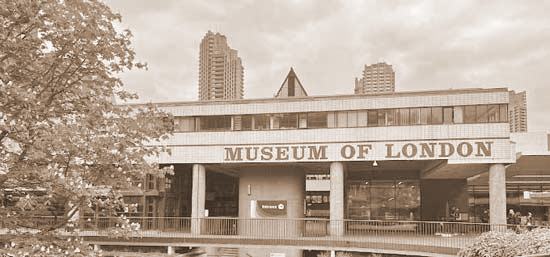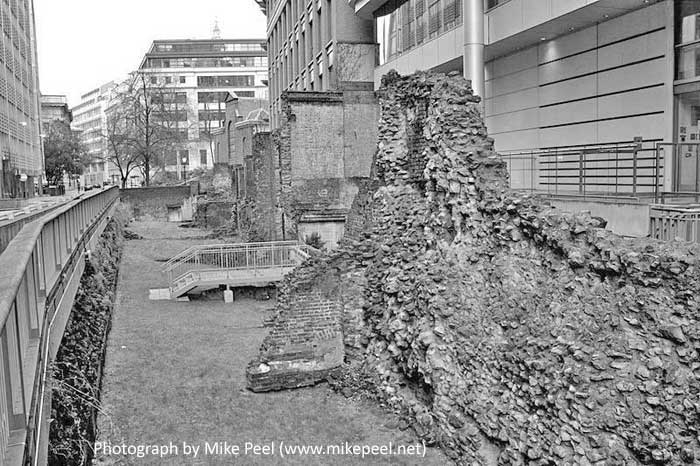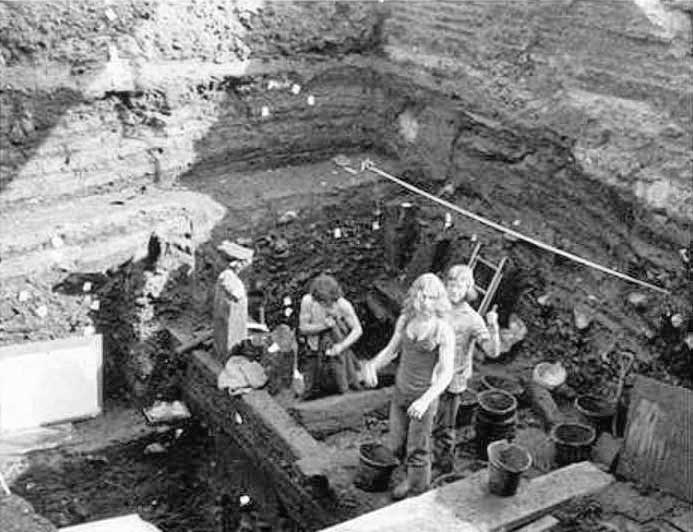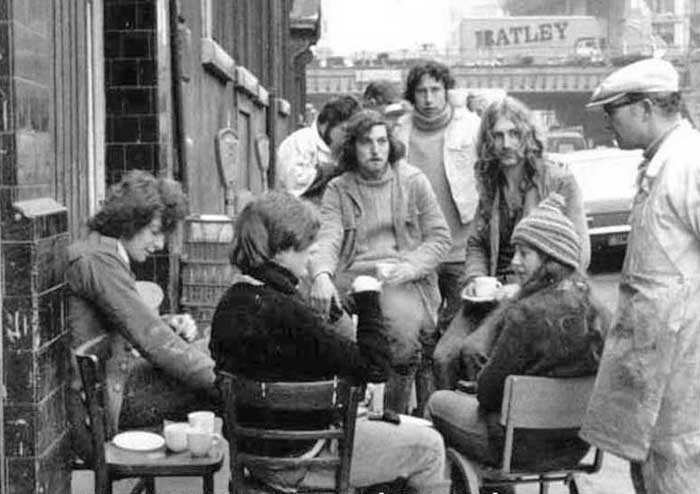1973: the Birth of the DUA
Gustav Milne
The ground-breaking Museum of London brought together the collections and expertise of the former London Museum (founded 1911) and the City’s own Guildhall Museum (founded 1826).
It formally opened in December 1976, but with great sadness, closed its doors for the last time in December 2022.

It has left significant legacies however, not least its contributions to urban archaeology. This article records the birth of the pioneering Department of Urban Archaeology, which began excavating on 3rd December 1973, three years before the Museum itself actually opened.
The site selected for this auspicious event was supposed to be at New Fresh Wharf, in Billingsgate. The last remnants of the Guildhall Museum digging team from the Customs House site (which had just closed in mid-November) were told to report there on that December day, and so Gustav duly turned up at the appointed hour. But as nobody else showed up, he headed back to the Guildhall Museum (then accommodated in temporary premises in Basinghall Street) to await further instructions. There he was joined by three seasoned Custom House excavation diggers, Peter Ellis, Peter Taylor and Martin O’ Connell.
In the footsteps of Professor Grimes
Since there were delays in getting access to the New Fresh Wharf site (Brian Hobley, the Chief Urban Archaeologist, had only just been appointed to that role and had not yet arrived in London), the diggers were given a fill-in job by Peter Marsden, the field officer for the Guildhall Museum. He took the team to Noble Street, adjacent to the remains of the west wall of Roman Cripplegate Fort. This had initially been recorded by Professor Grimes, working on the bombsite in the 1940s and 50s.
 Thus the very first DUA dig would require the excavation of three trenches to check the alignment of the fort’s intramural street and associated drainage ditch. Equipment was collected from a basement under the street called London Wall, where remains of the West Gate of the Roman fort had been exposed and preserved. The trenches were duly opened after stripping off much bomb rubble. The hard-packed gravel layers of the street were soon identified, together with dark brown ditch deposits cut into the ‘natural’ light brown brickearth. Peter Ellis, an accomplished draughtsman, then drew the exposed sections.
Thus the very first DUA dig would require the excavation of three trenches to check the alignment of the fort’s intramural street and associated drainage ditch. Equipment was collected from a basement under the street called London Wall, where remains of the West Gate of the Roman fort had been exposed and preserved. The trenches were duly opened after stripping off much bomb rubble. The hard-packed gravel layers of the street were soon identified, together with dark brown ditch deposits cut into the ‘natural’ light brown brickearth. Peter Ellis, an accomplished draughtsman, then drew the exposed sections.
There were two local cafes frequented for teabreaks, one in Little Britain, one in Gresham Street. Tea was 4p a cup with generous slices of bread pudding or a rock cakes (5p) in the former, but tea at Gresham Street (probably the Piccolo?) was only 3 1/2p.
Another New Beginning
On Monday 9th December 1973, the Guildhall Museum’s diggers were sent off to New Fresh Wharf, the first major excavation undertaken solely for the new DUA. The supervisor had just been drafted in from the Dover Rescue Archaeological team (and therefore trained in emergency salvage archaeological techniques). Apparently the main thrust of the excavation was to find the remains of St Botolph’s Church, destroyed in the Great Fire of 1666, as was usefully recorded on a blue plaque on the site’s perimeter wall. But first the disused office buildings which would become the excavation headquarters (site hut) had to be cleared out. The calendar on the wall recorded that this set of buildings had been abandoned in July 1970, over three years ago. After emptying the offices, tools and other equipment were transported there on a conveniently requisitioned Smithers & Skinner fish-porters barrow from the neighbouring fish market. Then the heavy machinery arrived, to break out the concrete, clear the first 1.5m of rubble overburden, after which the supervisor requested that a JCB dug a deep test trench to ascertain the (considerable) depth and nature of the archaeological deposits.
 Thus, on day one of the first formal DUA excavation, a machine ripped down through thick waterfront deposits that would later prove to be of medieval, Saxon and Roman date. There was little doubt that this waterfront site was of some archaeological significance, but the approach taken by the supervisor seemed somewhat at variance to the more measured techniques practised on the old Custom House site the previous summer. But over the next few weeks, things gradually resolved as more diggers arrived, and the supervisor’s methodology and approaches were refined by informed discussion.
Thus, on day one of the first formal DUA excavation, a machine ripped down through thick waterfront deposits that would later prove to be of medieval, Saxon and Roman date. There was little doubt that this waterfront site was of some archaeological significance, but the approach taken by the supervisor seemed somewhat at variance to the more measured techniques practised on the old Custom House site the previous summer. But over the next few weeks, things gradually resolved as more diggers arrived, and the supervisor’s methodology and approaches were refined by informed discussion.
Here was another deeply-stratified waterfront site, sharing many aspects of the work experienced at the old Custom House: a well preserved timber-built Roman quay, overlain by thick later medieval deposits, in this case including a late Saxon rubble, clay and timber embankment as well as the substantial fragments of a Saxon boat, all well preserved in the anaerobic conditions. This was very rich three-dimensional urban archaeology. The intake of intelligent, hardworking, committed excavators that had suddenly materialised from all points of the compass readily realised the remarkable potential of this site and detailed recording began: the DUA had finally arrived.
Everything Stops for Tea
Joe’s No 1 Café, Lower Thames Street 1974
Clockwise from left, Martin O’Connell, Graham Troillett, Peter Taylor, Gustav Milne, Charlotte Harding, Amanda McIlwain and fish porters.
Photograph from Louise Malkin (Miller)
STARTING A NEW FRESH ERA....
Chrissie Harrison (Milne)
January 1974 found me recently unemployed during the major recession and the infamous three-day-week, when electricity was ruthlessly rationed. It was also a major crossroad in my personal life. It really felt like it was time for a change so when Gustav (another recently unemployed victim of the recession) suggested working with him on an archaeological site for the Guildhall Museum, I jumped at the chance to do something new and interesting.
One cold, crisp wintery morning wearing a woolly jumper, flares and plimsolls, I enrolled as a volunteer and reported for duty at New Fresh Wharf. Long before the days of health and safety, boots weren’t the norm for women and I didn’t get my first pair of DMs until the more emancipated days of the early 80s. So few hard hats, no steel toe caps, and not much shoring.
Billingsgate fish market next door was still a hive of activity back then. All very busy in the morning and with the hustle and bustle of traders, porters and the local unemployed being paid pence to help push heavy fish barrows uphill. And, of course, the all prevailing fishy smell.
Modus Operandi
Back on site, I was given a trowel, bucket and hand shovel, directed to a stretch of upstanding chalk and flint medieval chequerboard wall… and told to clean it. Having no idea what clean meant in this context I gingerly scraped the top of the wall removing a minuscule amount of loose. After tea break, along comes the supervisor to check my progress. He wields the gleaming trowel like a mini pick axe and demolishes the upper 20cms or more of the wall. Ah I thought so this is what clean means…
We were a great team, loads of banter and gossip (what's the whisper?). It wasn't just the Wharf that was New and Fresh: so were half the excavators. Our oft-used phrase "the blind leading the blind" was rather more appropriate than we fully realised at the time: luckily we were all fast learners.
Such an amazing site with new discoveries every day (Saxon boat, tons of pottery, leather shoes and well preserved metal objects,) as we dug down to the Roman quay with 2 or 3m-high unsupported sections, but at least I learnt how to shovel up from such depths.
We weren't paid salaries of course, or sick pay or holiday pay: the volunteer 'fees-&-subsistence' rate was just £7.50 a week, paid in cash in a brown envelope. Remarkably with minimal expenses I managed to pay my rent and live on this money.
Thus began my 20-year long career in archaeology much of it working on waterfront sites on the north bank of the Thames, on both sides of Thames Street: New Fresh Wharf NFW74; Triangle TR74; Trig lane TL74-6; Bull Wharf BLL79; Peninsular House PEN79; Pudding Lane PDN81; Thames exchange TEX88.
As a child I was fascinated by Rudyard Kipling’s poem 'The Rivers Tale ' (they were young and the Thames was old, and this is the tale the River told) and I’ve always thought this shaped my fate and future bridging the gap between the poem and where your history books begin.




Comments powered by CComment